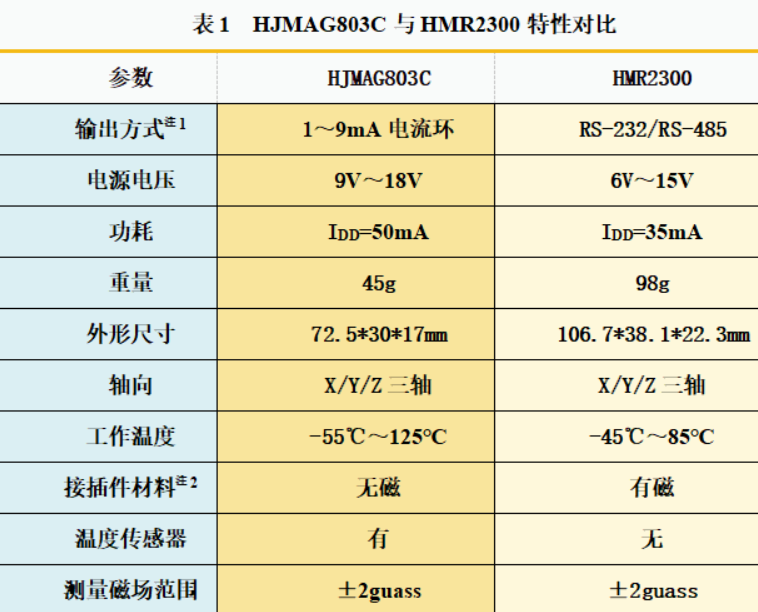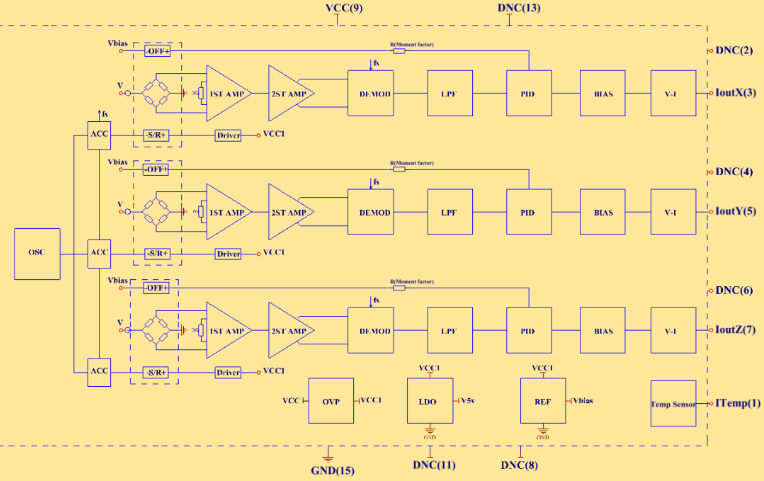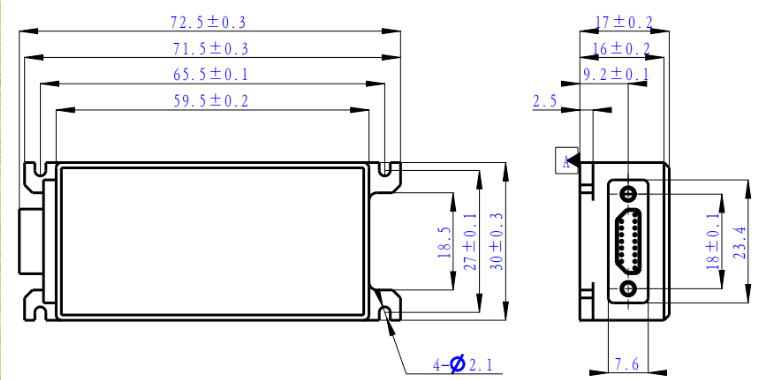HJMAG803C current-type three-axis high-precision weak magnetic measurement module
Release time:
2022-04-11
In practical applications of the magnetic measurement module in systems such as attitude control, pitch angle measurement
01 Background
The magnetic measurement module, when applied in systems such as attitude control, pitch angle measurement, and gamma measurement, often suffers from significant signal-to-noise ratio (SNR) loss due to the distance between the collector and the module, as well as potential signal relay. This adversely affects overall measurement accuracy. Additionally, with the increasing uncertainty in the international environment and escalating friction between China and the U.S., the suppression of China's integrated circuit industry by countries like the U.S. is gradually expanding. It is becoming increasingly difficult to procure imported integrated circuits, with prices soaring hundreds or thousands of times, severely impacting China's economic development and national security. Therefore, it is an inevitable trend for the integrated circuit industry to pursue domestic autonomy. In light of this situation, Hangjing Microelectronics has successfully developed a domestically produced three-axis magnetic measurement module after conducting preliminary market research, program validation, experimental verification, and leveraging its rich experience in magnetic measurement technology.
02 Overview
HJMAG803C is a current output type three-axis high-precision weak magnetic measurement module. This module employs modulation-demodulation technology and PID regulation technology to keep the magnetic sensor probe operating near zero Gauss. This helps eliminate interference from external strong magnetic fields (such as permanent magnets and strong electromagnetic pulses) while reducing drift at zero (dK0/dT) and secondary nonlinearity (K2). To assist users in temperature modeling correction, an AD590 is embedded internally to measure the local temperature of the sensor.
Considering that in practical applications, collectors are often far from modules and may involve relays that lead to significant SNR loss when transmitting analog voltage signals to endpoints—thus affecting measurement accuracy—this design adopts a current loop transmission method of 4~20mA for long-distance transmission of analog signals. However, considering thermal power consumption issues at a maximum of 20mA, it has been changed to 1~9mA output with a zero Gauss output of 5mA.
This magnetic measurement module utilizes the company's extensive engineering processing and practical experience in magnetic measurements during structural design, material selection, and processing to effectively ensure that its performance meets customer needs. Based on standard SJ20668-1998 'General Specification for Microcircuit Modules', it offers advantages over traditional voltage-type magnetic sensors such as long line driving capability, enhanced SNR, system operational state inspection capability, anti-interference features, high precision, high reliability, and good stability; it can functionally replace the HMR2300 three-axis magnetic measurement module produced in America. This module can serve various fields including aviation, aerospace, weaponry, and petroleum industries for applications in attitude control systems, pitch angle measurements, rotational speed measurements, and gamma measurements.

Note 1: The HMR2300 software control uses a non-isolated RS-232/RS-485 interface chip which is susceptible to common/differential mode interference from remote ground lines leading to errors; severe cases may damage its transceiver. Customers need to authenticate internal software compatibility during use. In contrast, HJMAG803C requires no programming internally; it outputs a current signal of 1~9mA which makes it more convenient compared to HMR2300 that requires internal programming while offering features like long line output capability with high SNR and precision.
Note 2: Due to material magnetism affecting connectors for ensuring measurement accuracy of the magnetic sensor; HMR2300's sensitive axis area is located on the right side of its shell while HJMAG803C uses non-magnetic materials for connectors with its sensitive axis area positioned at the geometric center of its shell.
03 Electrical Principle Block Diagram

04 Packaging Form and Lead Functionality
1. Packaging Form: Uses non-magnetic metal packaging with dimensions shown in figure (unit: mm).

Note: Shell dimensions: L*W*H=72.5*30*17mm; installation reference surface has been polished.
2. Lead Functionality
05 绝对最大值
06 电特性
除非另有说明,VCC=15±5%V,TA=25℃。
07 实物图
08 典型应用
09应用注意事项
1. The module uses a non-magnetic aluminum housing sealed by laser welding. The leads use J30J-15TJP non-magnetic aviation sockets laser welded onto the housing; thus this module's packaging is not hermetically sealed. During use cleaning agents should not be used for cleaning nor should other acids or bases be allowed to penetrate into it. Additionally any lead marked 'DNC' indicates an internal debugging port which must not be connected externally or come into contact with unrelated potentials; otherwise minor issues may disrupt operational status while severe cases could burn out the module.
2.The orientation of three orthogonal axes on this module can be seen in below diagram (top view).
3.Screws on four through holes (Φ2) should use non-magnetic screws for securing components.
4.As current generates magnetic fields care should be taken during layout design to avoid placing unidirectional large current lines close together so as not produce noise/drift at zero point; if distance cannot be increased then power supply lines should be arranged equidistantly along with return lines (i.e., GND), preferably twisted pairs if possible since this arrangement helps cancel out mutual fields generated by currents.
5.Although this module can reliably operate in environments where TA≥175℃ due limitations imposed by AD590's measuring range temperatures above125℃ cannot utilize internal temperature sensors for calibration purposes.
6.Due differences among various equipment assembly environments surrounding hard/soft magnetic interferences will ultimately cause variations in zero point(K0)and scale factor(K1)of three-axis outputs hence users are advised perform modeling corrections within their upper computer systems.
7.Place modules inside a magnetic shielding barrel or wrap them using permalloy materials then measure currents at long line endpoints; if reading shows5mA connection is normal otherwise first check if wiring has broken.
8.To improve system acquisition SNR customers are advised make nearby ground reference signals;
10. If used for aircraft geomagnetic navigation, the following work must be done:
A. The geographic North Pole of the Earth and the geomagnetic North Pole are not at the same point, so modeling correction is required;
B. Modeling correction must be performed for longitude; otherwise, the error during long-distance flight will be significant;
C. It must be integrated with a three-axis accelerometer to complete modeling corrections for the aircraft's pitch and roll angles;
D. For detailed principles and implementation, please refer to Honeywell's application article "Applications of Magnetoresistive Sensors in Navigation Systems."
11. The back of the module is the installation reference surface, which has been specially polished, so it must not be damaged.
10 Related Products
1. HJMAG803 three-axis high-precision weak magnetic measurement module
2. HJMAG803A high-temperature three-axis high-precision weak magnetic measurement module
3. HJMAG804 dual-axis high-precision weak magnetic measurement module
4. HJMAG805A high-precision geomagnetic reference speed measurement module
5. HJMAG805B high-precision geomagnetic reference speed measurement module
Key words:
Next Page
Next page:
recommend News
Looking for quality suppliers to create a better future together
Shaanxi Hangjing Microelectronics Co., Ltd. was established in 2001 and is located in the new industrial park
2024-07-09
A domestically produced LVDT/RVDT conditioner that replaces AD698
HJG698 is an LVDT/RVDT excitation demodulator designed using thick film integrated process
2024-04-01
A sensor processing circuit specifically designed for thermoresistor PT1000.
With the development of the Internet of Things era, sensors, as an important component
2024-01-11
Hangjing has announced the upgrade and optimization of domestically produced products.
In the spirit of being responsible to customers and continuous improvementction.
2023-08-12
Internal Appraisal Public Account
On April 2, 2022, Shaanxi Hangjing Microelectronics Co., Ltd. organized a product design confirmation meeting
2023-06-12
